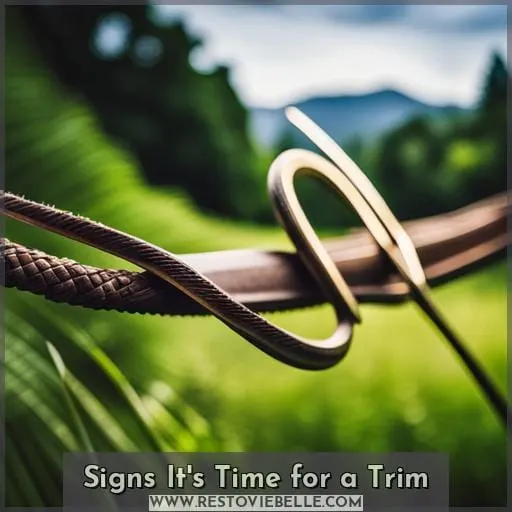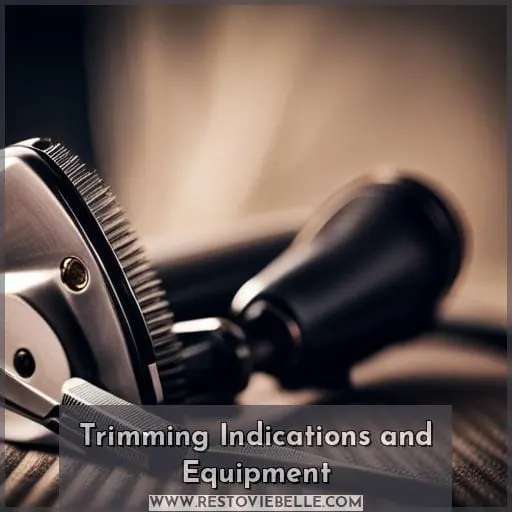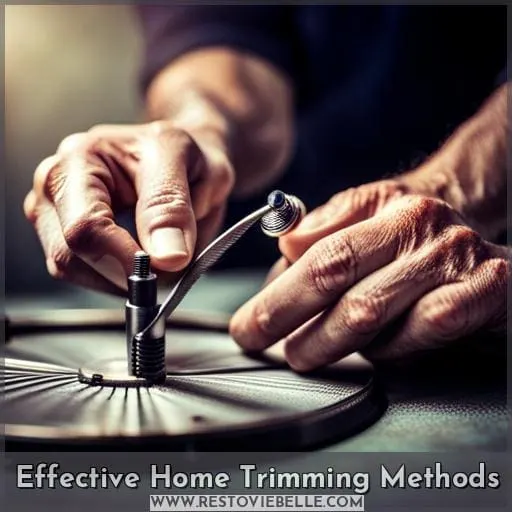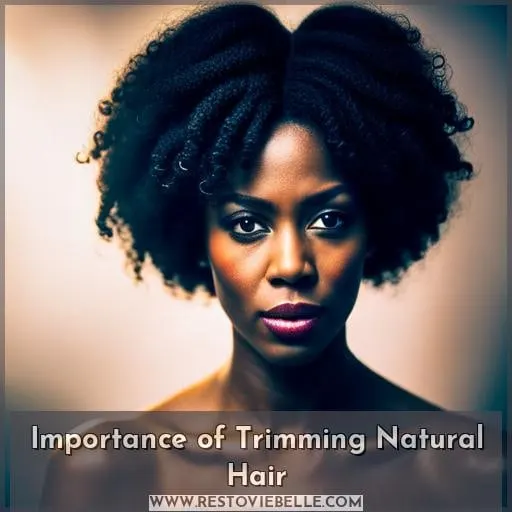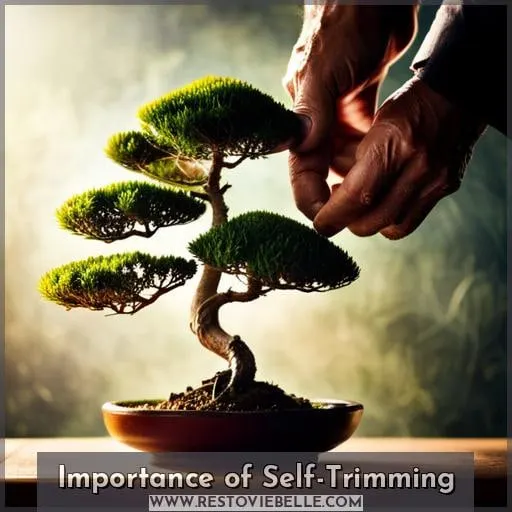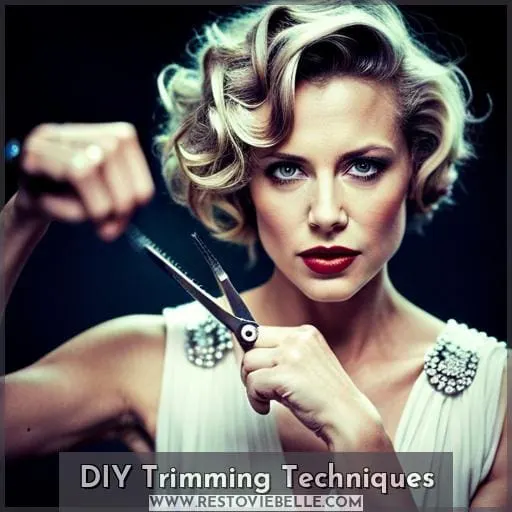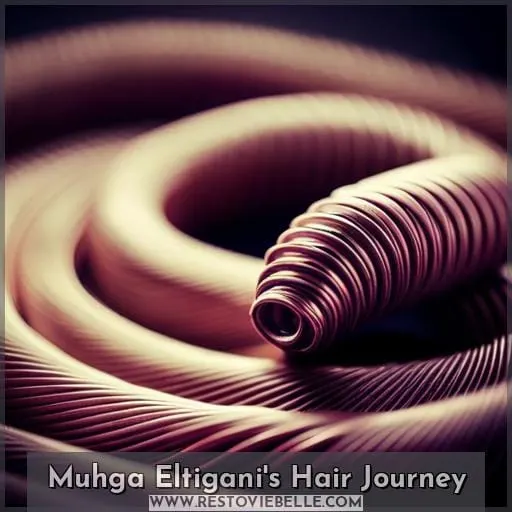This site is supported by our readers. We may earn a commission, at no cost to you, if you purchase through links.
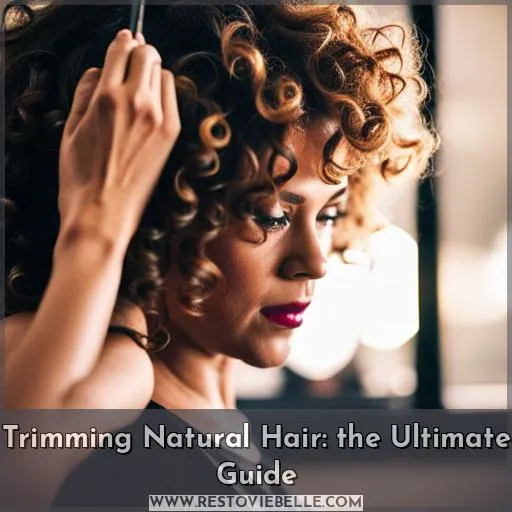 Ready to take control of your natural hair? Look no further! In this ultimate guide, we’ll show you the ins and outs of trimming natural hair. Say goodbye to split ends, frizz, and breakage as we provide expert tips on when it’s time for a trim and the best techniques to use.
Ready to take control of your natural hair? Look no further! In this ultimate guide, we’ll show you the ins and outs of trimming natural hair. Say goodbye to split ends, frizz, and breakage as we provide expert tips on when it’s time for a trim and the best techniques to use.
With our step-by-step instructions and advice from professionals in the industry, you’ll become a pro at maintaining healthy, beautiful natural hair.
Table Of Contents
- Key Takeaways
- Signs It’s Time for a Trim
- Trimming Indications and Equipment
- Effective Home Trimming Methods
- Hair Trimming Frequency and Benefits
- Maintenance and Community Engagement
- Importance of Trimming Natural Hair
- Reasons for Infrequent Trimming
- Importance of Self-Trimming
- DIY Trimming Techniques
- Muhga Eltigani’s Hair Journey
- Frequently Asked Questions (FAQs)
- Can I trim my natural hair with regular scissors?
- How can I prevent excessive breakage during the trimming process?
- Are there any alternative methods for trimming natural hair without heat or blow drying?
- What are some common mistakes to avoid when self-trimming natural hair?
- How can I maintain the health of my natural hair between trims?
- Conclusion
Key Takeaways
- Signs of trimming need include fairy knots, split ends, frizzy/dry ends, excessive breakage, and difficulty managing on wash days.
- Using sharp hair shears and proper equipment like wide-tooth combs is important for effective trimming.
- Blow-drying/stretching hair and using the two-strand twist method are effective home trimming methods.
- Regular trimming promotes length retention, reduces breakage, and improves hair health and manageability.
Signs It’s Time for a Trim
If you’ve noticed fairy knots or single strand knots in your hair, it’s a clear sign that it’s time for a trim.
Split ends are another indicator that your hair needs some attention.
When you style your natural hair and find frizzy, dry ends that just won’t cooperate, it’s a telltale sign of damage.
Excessive breakage during detangling and difficulty managing your hair on wash days are also signs that trimming is necessary to maintain the health and appearance of your natural locks.
Presence of Fairy Knots or Single Strand Knots
If you notice a few fairy knots or single strand knots in your natural hair, it’s time for a trim.
Proper knot prevention, hair hydration, styling solutions, and protective measures are essential for effective knot management.
Occurrence of Split Ends
When split ends start appearing, it’s a clear sign that it’s time for a trim.
Preventive measures like regular trims, moisture retention, and healthy hair care practices help prevent split ends and maintain hair health.
Noticeable Frizzy, Dry Ends After Styling
You’re likely ready for a trim when your strands become frizzy or crispy despite using your go-to stylers. This signals dehydration, requiring adjustments like protective styles, scalp oiling, and deep conditioning to restore moisture before trimming off split ends.
Excessive Breakage During Detangling
If you’re experiencing excessive breakage during detangling, it’s a clear sign that it’s time for a trim.
- Incorporate detangling hacks like using conditioner or detangling sprays to minimize breakage.
- Implement protein treatments and strengthening routines to fortify your strands and reduce fragility.
- Consider protective styles that minimize manipulation and friction on the hair, helping to prevent breakage during the detangling process.
Difficulty Managing Hair on Wash Days
If you’re struggling to manage your hair on wash days, it may be a sign that it’s time for a trim.
Hair Hydration
- Maintain moisture in your hair through regular deep conditioning treatments.
Scalp Care
- Take care of your scalp by keeping it clean and moisturized to promote healthy hair growth.
Protective Styling
- Protective styles like braids or twists can help minimize manipulation and reduce breakage.
[CURL DEFINITION]
[NIGHTTIME ROUTINE]
[HAIR MAINTENANCE TIPS]
[STYLING TEXTURED HAIR]
[HAIR TRIMMING MISTAKES]
[NATURAL HAIR CARE ROUTINE]
Trimming Indications and Equipment
When it’s time for a trim, be sure to use quality, sharp hair shears for precise cuts.
Avoid regular scissors, as they can cause uneven, jagged ends.
Opt for professional-grade equipment like a wide-tooth comb and shears to carefully section hair and trim damaged strands.
Importance of Quality, Sharp Hair Shears
When trimming your hair at home, invest in quality, sharp hair shears.
Regular scissors can cause uneven cuts and damage.
Choose the right shear type for precision trimming and practice proper maintenance to ensure longevity.
Recommended Trimming on Dry, Stretched Hair
To achieve the best results when trimming your natural hair, it’s recommended to trim on dry, stretched hair.
- Prevents inaccurate cuts
- Allows assessment of true length
- Reduces risk of breakage
- Enables precision sectioning
- Provides visibility of damaged areas
Caution Against Using Regular Scissors
Why are you tempting fate using regular scissors for at-home trims when investing in quality hair shears lets you achieve more precise, less damaging cuts?
Scissor selection is crucial for shear safety and precision trimming.
Avoiding Replication of Professional Cuts at Home
Preventing duplicating salon cuts at home, you’re better off leaving precision styling to the professionals. They’ve the expertise and tools needed for personalized, accurate trims that promote healthy hair care.
Utilization of Proper Equipment: Wide-tooth Comb and Quality Shears
All proper hair trimming requires:
- A wide-tooth comb for gentle detangling
- Quality shears for precise cutting
Select quality shears and maintain their sharpness for precision cutting.
Use a wide-tooth comb to gently handle tangles and prep hair for accurate trims.
Effective Home Trimming Methods
When trimming your natural hair at home, you can try techniques like:
- The blow-dried/stretched hair method
- The two-strand twist method
The blow-dried method involves gently sectioning and precisely cutting the ends once your hair is stretched, while the two-strand twist method uses small twists for accurate trimming.
Refer to visual tutorials for guidance on proper home trimming methods.
Blow-Dried/Stretched Hair Method
To trim your natural hair effectively at home, continue by:
- Blow-drying or stretching your hair to prepare for the cutting process.
- Blow-drying or stretching helps to create a smooth and taut surface, making it easier to identify and trim split ends.
- Be cautious of heat damage and ensure proper moisture retention during this step.
- Protective styles like buns or twists can also aid in stretching the hair without resorting to excessive heat.
- Remember that understanding your curl pattern is essential for achieving accurate trims while maintaining healthy growth.
Two-Strand Twist Method
The creation of two-strand twists allows you to precisely trim dry, frizzy ends in a simple, convenient way at home.
- The twisting technique permits precision trimming via angled cutting of frayed ends.
- Regular twist maintenance leads to healthier looking strands by removing split ends.
- Ideal for kinky, curly textures that easily form twists without manipulating hair texture.
- Enables personal control over trimming while retaining maximum length between professional appointments.
- Twist style provides styling versatility from defined twists to full twist-outs with volume.
Hair Trimming Frequency and Benefits
When it comes to trimming natural hair, experts recommend getting a trim every three months.
Regular trims not only help with length retention but also reduce breakage and promote healthier, more manageable hair.
Over time, consistent trimming can lead to a decrease in the amount of hair that needs to be trimmed and result in improved overall hair health and manageability.
Expert Recommendation: Trim Every Three Months
Experts recommend you trim your hair every three months to retain length and reduce breakage. This optimal trimming frequency balances growth and health. However, real-world challenges like affordability, accessibility, and cultural perspectives on hair length may impact individual trimming consistency.
| Frequency | Benefit |
|---|---|
| Every 3 months | Optimizes growth by preventing excessive split ends |
| Every 4-6 weeks | Maximizes moisture retention for certain textures |
| Twice a year | Allows longer growth periods preferred by some cultures |
Length Retention and Reduced Breakage With Regular Trims
Because you’re trimming your hair regularly, you’ll retain more length and experience less breakage over time.
Preventive trims remove damaged ends before extensive splitting, helping hair stay healthy as it grows out.
Making this consistent effort safeguards strands and promotes growth.
Consistent Trimming for Healthier, More Manageable Hair
You’re keeping your hair healthier and more manageable by trimming it consistently.
Reduces knots and tangles
Allows easier styling
This maintains your hair’s integrity through seasonal changes and heat damage while allowing you to style and protect it with greater ease.
Decrease in Amount of Hair Needing Trimming Over Time
When you trim your hair consistently, you’ll eventually require less trimming over time.
Through progressive trimming and long-term care, trimming strategies promote gradual maintenance for sustainable results, needing less over time.
Improved Hair Health and Manageability With Routine Trims
You’ll notice improved hair health and easier manageability when you trim your locks routinely every three months.
Reduced breakage and knots
Better moisture retention
Enhanced shine and silkiness
Maintenance and Community Engagement
Now that you’ve learned about the importance of trimming natural hair and the frequency at which it should be done, let’s talk about maintenance and community engagement.
Engaging with others in a community can provide valuable insights, feedback, and support on your hair care journey. By creating an interactive space for ongoing engagement, you’ll have the opportunity to share knowledge, learn from others’ experiences, and strengthen your own understanding of trimming techniques.
So don’t hesitate to leave comments or ask questions as we delve deeper into this topic together!
Encouragement for Comments, Feedback, and Personal Experiences
Share your thoughts, experiences, and feedback in the comments section to foster a community discussion on hair care and trimming.
- Exchange tips
- Share personal stories
- Engage with others who are also passionate about maintaining healthy natural hair.
Your contributions help create an interactive space for ongoing learning and growth.
Fostering Community Discussion on Hair Care and Trimming
To foster community discussion on hair care and trimming, it’s important to actively engage with others and share your personal experiences.
- Openly discuss trimming challenges and solutions.
- Share tips, tricks, and best practices.
- Provide personal anecdotes and experiences.
By creating an open dialogue around hair care and trimming, we empower each other through shared knowledge and support.
Creating an Interactive Space for Ongoing Engagement and Support
Engage with a supportive community and maintain ongoing discussions about hair care and trimming to foster a space of interaction and support.
Through virtual workshops, live demos, and Q&A sessions, you can find peer support to tackle community challenges together.
Importance of Trimming Natural Hair
In regard to the health of your natural hair, trimming split ends occurs because they can lead toward increased tangles and breakage risks if left untrimmed over time.
Regular trims every three to four months help maintain strong, healthy strands by preventing further splitting.
Skipping trims causes more significant damage, requiring removing more length later.
Addressing split ends through strategic trimming retains moisture, enabling easier styling and preventing knots.
Seeking preventative care preserves growth and balances moisture.
Employ natural remedies like oil treatments before gently trimming damaged areas.
Monitoring hair health prevents excess breakage, retaining length.
Proactively trimming stimulates stronger regrowth.
Ultimately, consistent trimming ensures hair longevity, empowering your natural hair journey through strategic maintenance.
Reasons for Infrequent Trimming
When it comes to trimming natural hair, there are several reasons why people may choose to trim infrequently.
One common reason is the fear of losing length with each trim, as many believe that frequent trims can hinder hair growth.
Additionally, factors such as scheduling conflicts, affordability concerns, or simply a lack of motivation can contribute to delaying trims.
However, it’s important to understand the benefits of regular trims and find a balance between maintaining length and promoting healthy hair.
Trimming frequency and benefits
You’ll want to trim your hair every 3-4 months to maintain healthy strands and prevent excessive split ends or breakage, though many delay regular trims due to concerns over losing length or challenges like affordability.
Trimming every 12-16 weeks promotes hair health and retention.
Skipping trims can cause more splitting and breakage over time.
Getting consistent trims helps hair grow longer by preventing further damage.
DIY trimming techniques
To address the reasons for infrequent trimming, let’s explore some DIY techniques that can help maintain healthy natural hair.
Precision trimming is key to achieving even and balanced results.
Tension-free cuts ensure minimal breakage while layering methods add dimension without sacrificing length.
Consider your hair texture when choosing cutting techniques, and remember that practicing these skills will boost your cutting confidence.
Professional trimming advantages
One should book appointments with hair professionals because they accurately assess damage and perform precision trimming that preserves length.
- Skilled examination of hair health
- Careful sectioning and cutting
- Consistent angles and evenness
Importance of Self-Trimming
Getting into self-trimming saves you time and gives you personal control over your hair’s length. By taking matters into your own hands, you can achieve precision control in maintaining the health and appearance of your natural hair.
Self-trimming allows for personalized maintenance without relying on salon visits, resulting in financial savings. It also boosts DIY confidence as you become more skilled at handling your own hair care needs.
Here are some benefits of self-trimming:
| Benefits | Emotional Response |
|---|---|
| Precision Control | Feel empowered to take charge of your own style and destiny |
| Personal Maintenance | Experience a sense of mastery over caring for yourself from root to tip |
| DIY Confidence | Gain satisfaction from successfully executing professional-level techniques at home |
| Financial Savings Feel liberated by saving money that can be used towards other aspects of self-care |
Self-trimming isn’t only about achieving the desired length but also about nurturing a deeper connection with yourself through regular maintenance rituals. Embrace this opportunity to harness power and liberation while mastering the artistry required for perfecting natural hair trims.
DIY Trimming Techniques
Start by gathering the necessary tools and products for your DIY trimming session.
To achieve DIY precision, invest in a pair of sharp hair shears specifically designed for cutting natural hair. Avoid using regular scissors as they can cause uneven cuts and damage to your strands. If you’re looking for tool alternatives, consider using wide-tooth combs to help with detangling and sectioning your hair during the trimming process.
When it comes to texture adaptation, different methods work best depending on your specific hair type and length.
For those with blow-dried or stretched hair, start by stretching your locks using a blow dryer or heatless methods like braiding or banding. Then gently detangle each section with a wide-tooth comb before making precise cuts at the trimming point.
Another technique is the two-strand twist method which works well for quick maintenance between professional trims. Create small twists throughout your head and trim any dry, frizzy ends diagonally to maintain an even shape.
Remember that incorporating natural ingredients into styling versatility can also be beneficial when self-trimming at home.
Muhga Eltigani’s Hair Journey
Continuing the discussion on DIY trimming techniques, let’s delve into Muhga Eltigani’s inspiring hair journey.
Muhga is known for her dedication to natural hair care and has had a significant impact on the community through her YouTube channel and ingredient experiments.
Her routine involves regular trims every three months to maintain healthy strands.
As part of her transition experience, she shifted to using natural ingredients after experiencing damage from chemical treatments.
For six months, she exclusively used household items like avocado and coconut oil for nourishing treatments.
Through sharing her experiences and recipes via YouTube, Muhga has fostered a strong sense of community engagement in the world of natural hair care.
Her commitment to self-care and experimentation with ingredients has empowered countless individuals seeking liberation, power, and mastery over their own natural hair journeys.
- Regular trims every three months
- Transitioning from chemical treatments
- Exclusive use of natural ingredients
- Engaging with the online community through YouTube
- Sharing personal experiences
Frequently Asked Questions (FAQs)
Can I trim my natural hair with regular scissors?
Regular scissors aren’t recommended for trimming natural hair.
Invest in quality, sharp hair shears to ensure precise cuts and minimize damage.
Professional-grade tools will empower you on your journey towards mastery of your own hair care.
How can I prevent excessive breakage during the trimming process?
To prevent excessive breakage during trimming, ensure your hair is properly moisturized and detangled.
Use sharp hair shears to make clean cuts, avoiding regular scissors.
Trim small sections at a time for better control and accuracy.
Are there any alternative methods for trimming natural hair without heat or blow drying?
Yes, you can trim natural hair without heat by using the two-strand twist or finger coil method.
Carefully section dry hair.
Twist strands between fingers into coils.
Cut damaged ends diagonally across each coil with quality shears for an even trim.
This allows precision without blow drying.
What are some common mistakes to avoid when self-trimming natural hair?
As a flower yearns for rain, avoid uneven sections that lead to lopsided cuts.
Rushing trims without proper tools risks damage.
Let patience and care bloom to nurture healthy strands.
How can I maintain the health of my natural hair between trims?
Gently detangle hair when damp.
Moisturize regularly, focusing on ends.
Use silk pillowcases and low manipulation styles.
Spot trim any noticeable split ends between professional trims.
This supports healthy hair growth.
Conclusion
To achieve healthy and fabulous natural hair, proper trimming is essential. By following the tips and techniques outlined in this ultimate guide, you can say goodbye to split ends, frizz, and breakage.
Recognize the signs that it’s time for a trim, invest in quality hair shears, and choose the right method for your hair type. Regular trims every three months will lead to length retention, reduced breakage, and more manageable hair.
Join our community and engage in discussions to support your hair journey. Start taking control of your natural hair today!

